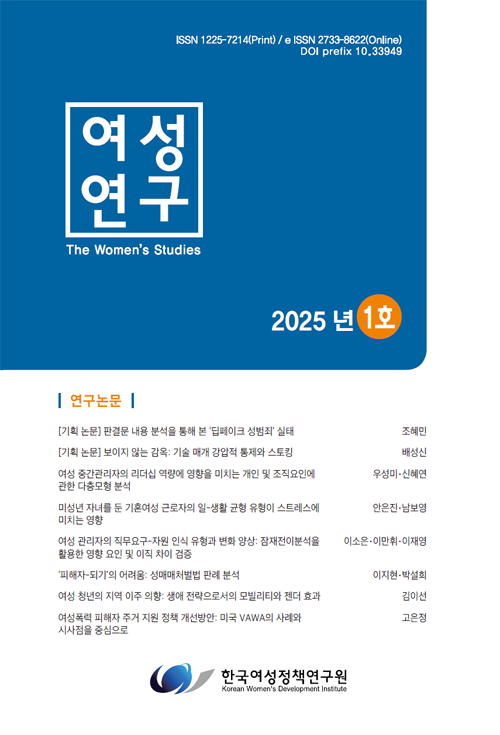‘피해자-되기’의 어려움: 성매매처벌법 판례 분석
The Difficulty of ‘Becoming a Victim’: Analysis of Legal Cases in The Act on the Punishment of Arrangement of Commercial Sex Acts
- 한국여성정책연구원(구 한국여성개발원)
- 여성연구
- 통권 제124호
-
2025.03149 - 180 (32 pages)
-
DOI : 10.33949/tws.2025.124.1.006
- 11

본 연구는 2004년부터 2023년까지 성매매처벌법 판례를 분석하여 “성매매피해자의 인권 보호”라는 입법 목적에 실제 판례들이 부합하는지 검토한다. 특히 성매매 여성이 ‘성매매피해자’와 ‘성을 파는 행위를 한 사람’으로 분류되는 기준에 초점을 맞추고자 한다. 성매매 여성의 법적 지위는 경찰·검찰·법원 단계에서 결정된다. 현행 성매매처벌법에서 당사자가 피해자로 인정받기 위해서는 스스로 피해자라고 주장해야 한다. 그러나 피해자의 지위는 판단 주체의 재량에 따라 비일관적으로 결정되고, 대부분은 행위자로 분류되고 있다. 또한 피해자로 접수된 사건도 언제든 행위자로 전환될 수 있어, 성매매 여성은 지속적으로 법적 신분 변경에 대한 위험에 노출된다. 판례 분석 결과, 성매매피해자 인정 기준은 모호하게 적용되었다. 위계나 위력, 그 밖에 이에 준하는 방법은 행위가 구체적으로 특정되지 않아, 극단적인 폭력 상황에 이르러서야 피해자로 인정되는 사례도 있었다. 법률의 객관적인 적용이 가능하다고 여겨지는 청소년이나 장애가 있는 여성의 경우나, 인신매매나 선불금 문제가 포함된 사건에서도 유사한 비일관성이 확인되었다. 심지어는 여권 압수, 감금, 상해와 같은 피해가 있었음에도 여성이 행위자로 분류되는 판례도 있었다. 이러한 연구 결과를 바탕으로 이 연구는 성매매처벌법의 취지가 법 집행 과정에서 충분히 구현되지 못하고 있음을 확인했다. ‘진정한 피해자’를 선별한다는 모호하고 비일관적인 기준은 성매매 여성에게 이중 잣대로 작용하며 더욱 폭력적 상황으로 내몰고 있다. 따라서 성매매처벌법은 현재의 이분법을 넘어, 성매매 여성의 비범죄화를 통해 패러다임의 전환을 이루어야 한다.
This study analyses the precedents related to the Act on the Punishment of Arrangement of Commercial Sex Acts from 2004 to 2023. Its main purpose is to examine whether the legal benefit of ‘protecting the human rights of victims of prostitution’ is actually applied in accordance with its intended purpose. In particular, this study reviews, review the criteria for classifying women in prostitution as either “victims of prostitution” or “persons in commercial sex acts”. The legal status of women in prostitution is determined at the police, prosecutor, and court levels. Under the current Act on the Punishment of Arrangement of Commercial Sex Acts, individuals must claim to be victims in order to be recognised as such. However, victim status is often determined at the discretion of judges without consistency, and most of victims are classified as persons in commercial sex acts. Moreover, even cases registered as victims can be converted to persons in commercial sex acts at any time, exposing women in prostitution to the constant risk of changes in their legal status. The case analysis shows that the criteria for recognizing victims of sexual prostitution are applied ambiguously. There are some cases involving a deceptive scheme, force, or equivalent thereto. And the victims were not specifically identified until the situation reached an extreme level of violence. Inconsistency was found in cases of juveniles or women in prostitution with disabilities, as well as human trafficking and cases involving pre-payments, which are usually considered to be applied with more objective criteria. And even there were instances that women were classfied as persons in commercial sex acts even though they experienced passport confiscation, confinement, and bodily injury. Finally, the study shows that the purpose of the Act on the Punishment of Arrangement of Commercial Sex Acts is not being fully implemented in legal interest. The ambiguous criteria for seeking ‘real victims’ have been working as a double standard for women in prostitution. This legal inconsistency is pushing women in prostitution into more violent situations. Thus it is necessary to move beyond the current Act on the Punishment of Arrangement of Commercial Sex Acts’ dichotomy of voluntariness/involuntariness. It is required to shift the paradigm towards decriminalization of women in prostitution.
Ⅰ. 문제제기
Ⅱ. 연구방법 및 연구대상
Ⅲ. 이론적 논의
Ⅳ. 성매매처벌법 적용의 구조적 한계
Ⅴ. 처벌과 면책 사이: ‘성을 파는 행위를 한 사람’에 대한 이중적 기준
Ⅵ. 결론
참고문헌
(0)
(0)